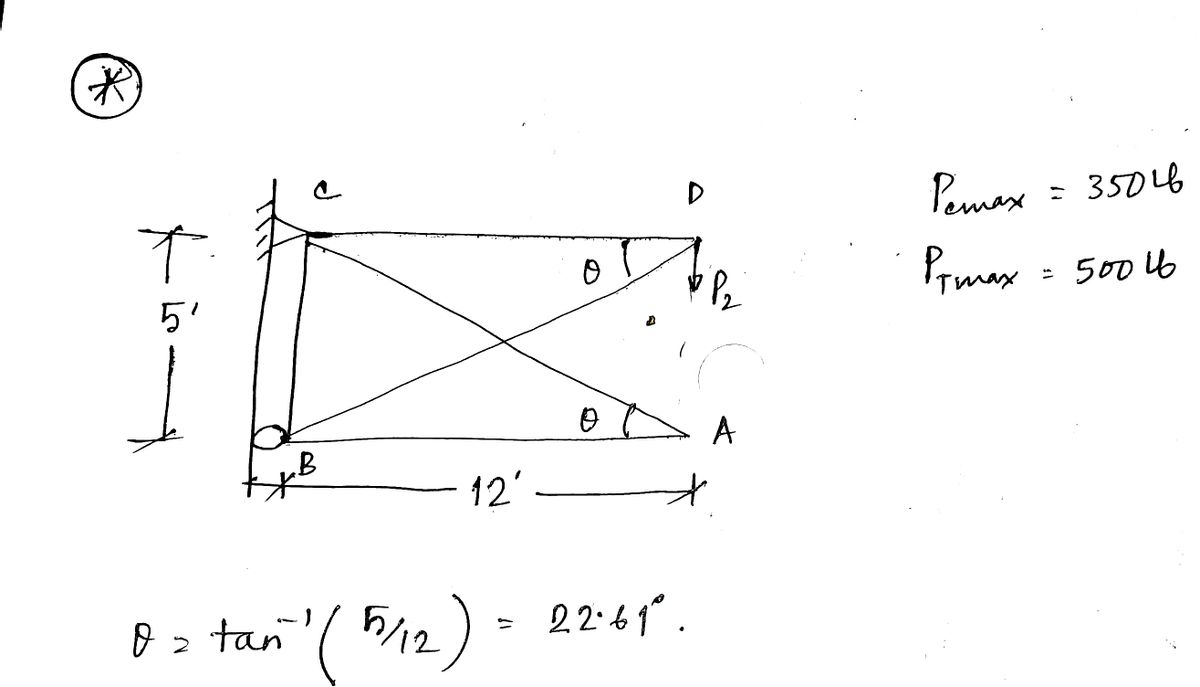Determine the largest load P2 that can be applied to the truss so that the force in any member does not exceed 500 lb (T) or 350 lb (C). Take P₁ = 0. 5 ft C B 12 ft D P2 A
Determine the largest load P2 that can be applied to the truss so that the force in any member does not exceed 500 lb (T) or 350 lb (C). Take P₁ = 0. 5 ft C B 12 ft D P2 A
Chapter2: Loads On Structures
Section: Chapter Questions
Problem 1P
Related questions
Question

Transcribed Image Text:**Problem Statement:**
Determine the largest load \( P_2 \) that can be applied to the truss so that the force in any member does not exceed 500 lb (Tensile) or 350 lb (Compressive). Take \( P_1 = 0 \).
**Truss Description:**
- **Type:** Simple truss with a pinned support at point B and roller support at point A, forming a structurally stable framework.
- **Configuration:** The truss consists of four main joints labeled A, B, C, and D, forming a rectangular shape with additional cross-bracing members.
- **Dimensions:**
- Horizontal span (between A and D) is 12 ft.
- Vertical distance (between B and C) is 5 ft.
**Members:**
The truss has the following members:
- Horizontal members: AB (support at B) and CD.
- Vertical members: AD and CB.
- Diagonal cross-bracing: AC and BD.
**Load Conditions:**
- **P2:** A vertical downward load applied at joint D.
- **P1:** Horizontal load, taken as 0 for this analysis.
**Objective:**
Calculate the maximum permissible \( P_2 \) while ensuring that:
- No member has a tensile force exceeding 500 lb.
- No member incurs a compressive force greater than 350 lb.
Expert Solution
Step 1

Step by step
Solved in 3 steps with 3 images

Knowledge Booster
Learn more about
Need a deep-dive on the concept behind this application? Look no further. Learn more about this topic, civil-engineering and related others by exploring similar questions and additional content below.Recommended textbooks for you


Structural Analysis (10th Edition)
Civil Engineering
ISBN:
9780134610672
Author:
Russell C. Hibbeler
Publisher:
PEARSON

Principles of Foundation Engineering (MindTap Cou…
Civil Engineering
ISBN:
9781337705028
Author:
Braja M. Das, Nagaratnam Sivakugan
Publisher:
Cengage Learning


Structural Analysis (10th Edition)
Civil Engineering
ISBN:
9780134610672
Author:
Russell C. Hibbeler
Publisher:
PEARSON

Principles of Foundation Engineering (MindTap Cou…
Civil Engineering
ISBN:
9781337705028
Author:
Braja M. Das, Nagaratnam Sivakugan
Publisher:
Cengage Learning

Fundamentals of Structural Analysis
Civil Engineering
ISBN:
9780073398006
Author:
Kenneth M. Leet Emeritus, Chia-Ming Uang, Joel Lanning
Publisher:
McGraw-Hill Education


Traffic and Highway Engineering
Civil Engineering
ISBN:
9781305156241
Author:
Garber, Nicholas J.
Publisher:
Cengage Learning